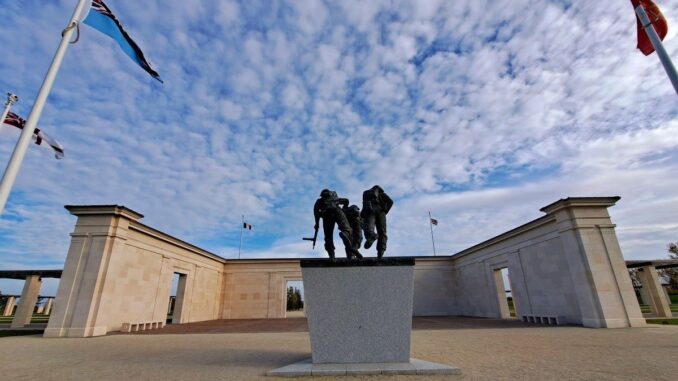
With 2024 marking the 80th anniversary of D-Day, Ramy Salameh takes an early chance to follow key parts of the 4,000km Liberation Route Hiking Trails, ahead of next year’s commemorations, taking in the pivotal sites across Hampshire, Normandy and Jersey, all navigational via an interactive smartphone app.
Under the forested canopy of woodland, parkland, rural villages and hidden compounds, stretching along the south coast, the greatest amphibious assault on mainland Europe was being prepared, known to us by the names ‘Operation Overlord’ and ‘D-Day’.
“Portsmouth and the greater Hampshire region is where I suggest starting your Liberation Route journey to understand the build-up and preparation for D-Day” Ben Mayne states, the UK Director of the Liberation Route Europe (LRE). He should know, as a WWII historian and battlefield guide, having created a continuous 200km trail in Portsmouth and beyond, selecting 100 points of interest, which forms just part of a much wider network of long-distance transnational trails, synergised with shorter themed routes.
Nerve centre of D-Day preparations
Just 5 miles from the centre of Portsmouth, the quintessentially English village of Southwick, with its local pub, parish church, thatched roofs and half-timber cottages are all indelibly linked to D-Day. From April to June 1944, this was the ‘nerve centre’ of allied planning, strategy and operations.
Within Southwick Park and its leafy surroundings, overall commander of the Supreme Headquarters of the Allied Expeditionary Force (SHAEF) General Dwight D Eisenhower, took the momentous decisions which would change the course of history, eventually leading to the end of WWII.
Southwick seems little changed since those tense and heady days in 1944. The Golden Lion Pub, served as the unofficial officer’s mess. It is adorned with WWII ephemera, with walls framing press cuttings which quote the former barmaid who served Eisenhower and Montgomery, as they sat in a dark corner sipping ale and lemonade, whilst placing fingers across ordinance maps. Current publican Greg Clark, an expert himself on the pub’s unique place in history, stated: “If only these walls could talk; I am so lucky to run the Golden Lion, I have met so many interesting characters, from Veterans to Ike’s (Eisenhower’s) grandson each with their own incredible stories”.
The Golden Lion is the perfect start and end point from which to hike out and explore the countryside’s closely held secret’s, such as the exact woodland locations where Eisenhower and Montgomery camped. Taking in Hampshire’s rolling landscapes of fields, pathways and forests, this short 5km trail circuits the estate, which is still owned and been in the Thistlethwayte family for nearly 500 years. Following behind our guide, he was eager to point out that SHAEF’s top brass camped away from the HQ for their own security purposes, however, Eisenhower would often walk from his camp at ‘Sharpener Woods’, across forests and open fields to reach Southwick House, the HQ of operations, as a means of contemplation.
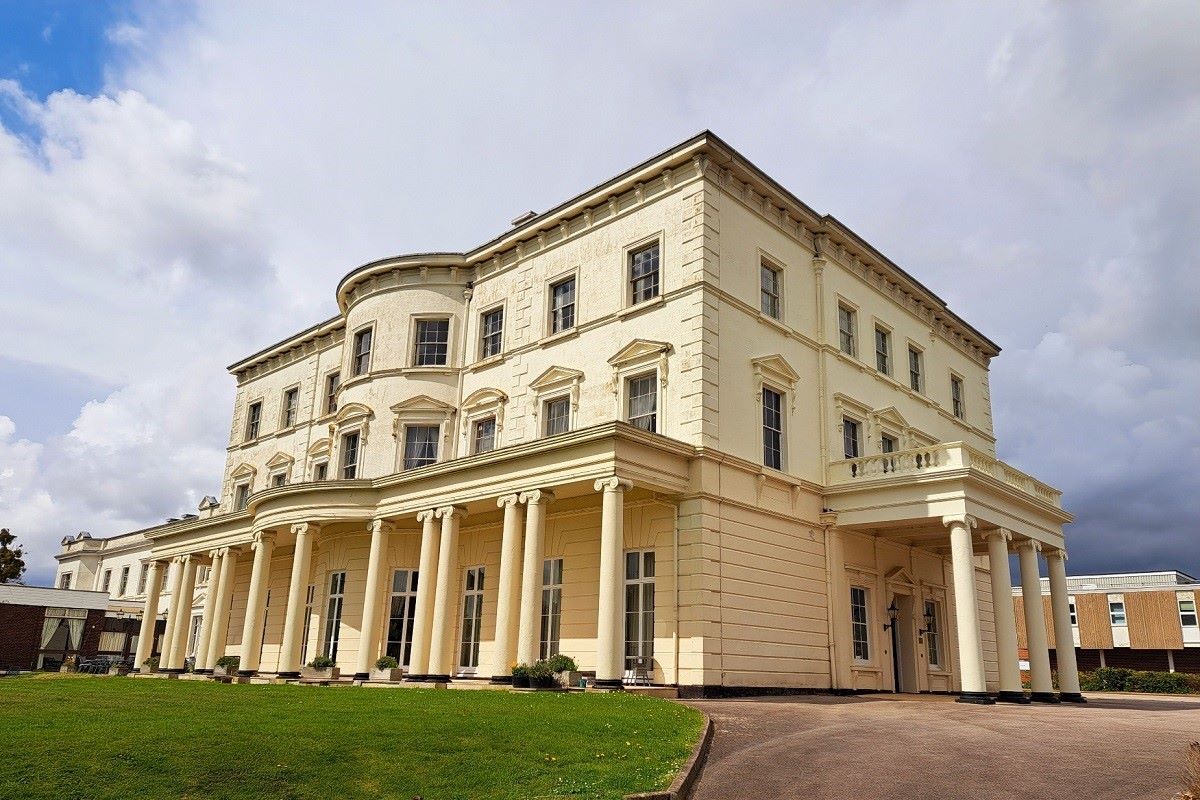
Southwick House
‘Southwick House’, a grade II listed Georgian mansion, today sits within an MOD Military Training base. In 1944, ahead of D-Day it was the beating heart of allied operations. Walking through the colonnaded entrance, before turning left into the oak-panelled ‘Map Room’ is a living history moment. One entire wall covets the original wooden map that sets out ship and troop movements, which unfolded during Operation Overlord. One can clearly imagine the space, busy with operational staff, such as ‘Wrens’, tasked with physically updating the map as information was received from the underground communications headquarters situated 100ft underneath Fort Southwick.
Next door, in the former Library, a plaque on the wall signifies its historic importance – “In this room on the fifth day of June 1944 General Dwight D Eisenhower made the historic decision to launch the assault against continental Europe on the 6th June, despite uncertain weather conditions”, having consulted meteorologists, the operation was already delayed by 24 hours before Eisenhower turned to assembled generals saying the now, iconic words “Okay we’ll go. We will sail tomorrow”.
Martialling camps, Embarkation Points and the D-Day Tapestry
Nearby Southwick Village, ‘Creech Woods’ became one of many, martialling and assembly camps ahead of D-Day, some 3,850 troops and 300 vehicles were camped in this particular woodland. To visualise the complexity of logistics, Ben Mayne laid on the forest floor his silk map; feeling like we were being briefed for our own military operation, he pointed to various green areas on the map, all of which contained thousands of battle-ready troops corralled into assembly camps, waiting for the order to deploy.
Soon this mass of men and machinery would be funnelled into Embarkation points, onto ships and landing crafts. Our hiking trail uncovered everything from decaying vestiges of the camp’s field kitchen deep within the undergrowth of ‘Creech Woods’, through to the reinforced concrete matting, beside the coastline and known as ‘Chocolate Blocks’, which allowed tanks to reverse onto the landing craft. These are visible today at Gosport Hardway.
More than 800 landing craft were used in the Normandy Landings of 1944, out of these, just one exists today and forms part of ‘The D-Day Story’ museum; Landing Craft Tank (LCT7074) sits outside the museum, having been salvaged from the bottom of a Liverpool harbour. Used as a former nightclub, the sympathetic renovation gives visitors a first-hand insight of standing on a landing craft next to one of ten tanks which would have squeezed onto such craft in 1944. At the heart of the D-Day story and for which the museum was built around, is the 83-meter long ‘Overlord Embroidery, charting those who took part and the Battle for Normandy.
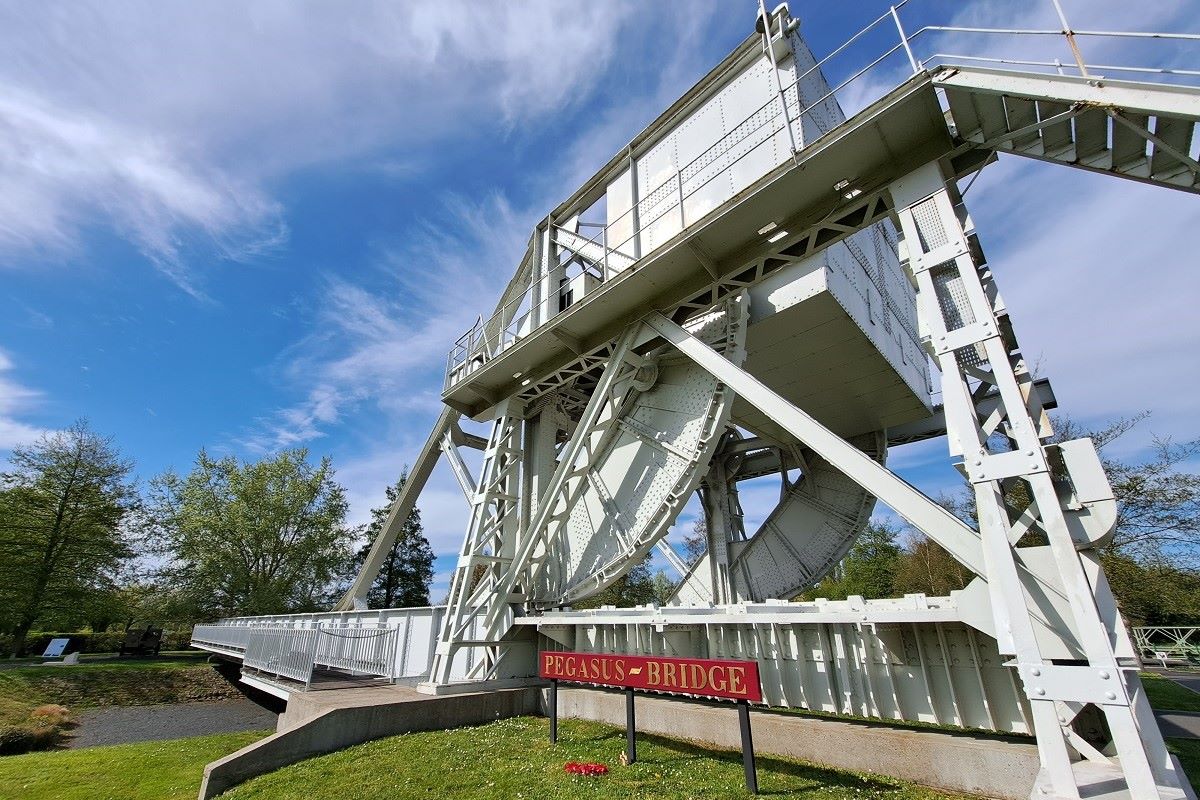
Normandy and the D-Day landings
Leaving Portsmouth Harbour heading to Caen, we were tracking the exact route the liberators took on the 6th June 1944. After several hours, we docked at the modern port of Ouistreham, to our right ‘Sword’ beach thronged with kite flyers to land yachts sharing the beach with families and dog walkers. In 1944 troops disembarked into the sea struggling towards the beach, weighed down with equipment under a barrage of bullets, shrapnel and mortar coming from heavily fortified German coastal defences.
We had come to continue our Liberation Route hike and explore a region criss-crossed by cycle paths and trails, which interweave the connected landing beaches of ‘Sword, Juno, Gold, Omaha and Utah’ evoking emotional stories, battles and personalities who liberated Europe, with the rustic and scenic landscapes of Northern France.
Our first mission was to reach Pegasus Bridge following the Orne Canal, just as the 6th Airborne division had done in their ‘Horsa Gliders’ during the very early hours of 6th June 1944, signalling the start of ‘Overlord’. Following staccato lines beside the canal, we were soon unravelling the audacious plans to capture the bridge, within the compact and artefact filled ‘Memorial Pegasus’ Museum. The original bridge sits within the grounds of the museum, bearing the scars of the assault and next to a replica ‘Horsa Glider’. On the other side of the waterway is ‘Café Gondree Benouville’, draped in allied colours and forever welcoming veterans through the door, as it was officially the first house in France to be liberated.
Hiking along the famous beaches
Hiking adjacent to the water’s edge, the gentile pace of life in the Calvados region made it hard to imagine the brutality of events of nearly 80 years ago across these selected landing zones. That is until you witness the scarred remains of the ‘Atlantic Wall’, the western bastion of ‘Festung Europe’ (fortress Europe). Beside the ‘Juno Beach Centre’ we entered a preserved German bunker and command post built in 1941-42. Lost to time and discovered below 20-tonnes of excavated sand, it forms a highlight of the museum, which pays homage, in many multi-sensory ways, to the Canadian 3rd Division that came ashore during D-Day.
From here the Liberation Route Hiking Trail, takes a beach front path once again, passing the French monument, ‘Croix de Lorraine’, significant as the point at which General de Gaulle set foot on French soil on the 14th June 1944. As we entered the landing zone of ‘Gold Beach’, our interactive map, highlighted the story of Company Sergeant Major Stanley Hollis, who won the only Victoria Cross to be awarded on 6th June 1944.
Following his story and remarkable bravery, meant we veered inland at Ver-sur-Mer; tracking the exact route Hollis and comrades took to reach the gun emplacements at Mont Fleury Battery; Hollis single-handedly stormed two pillboxes with grenades and Sten Gun, thus silencing this strong-point and taking German prisoners. This contributed to British Forces being at the gates of Bayeux on the evening of the 6th June.
A short walk from Hollis’s gallantry at Mont Fleury, the British Normandy Memorial has etched the names of 22,442 servicemen and women from 38 different countries who died during the Battle of Normandy. Their inscriptions adorn the ‘memorial court’ and stone piers, which form the ‘Cloister Garden’ looking out towards ‘Gold’ beach for time immemorial.
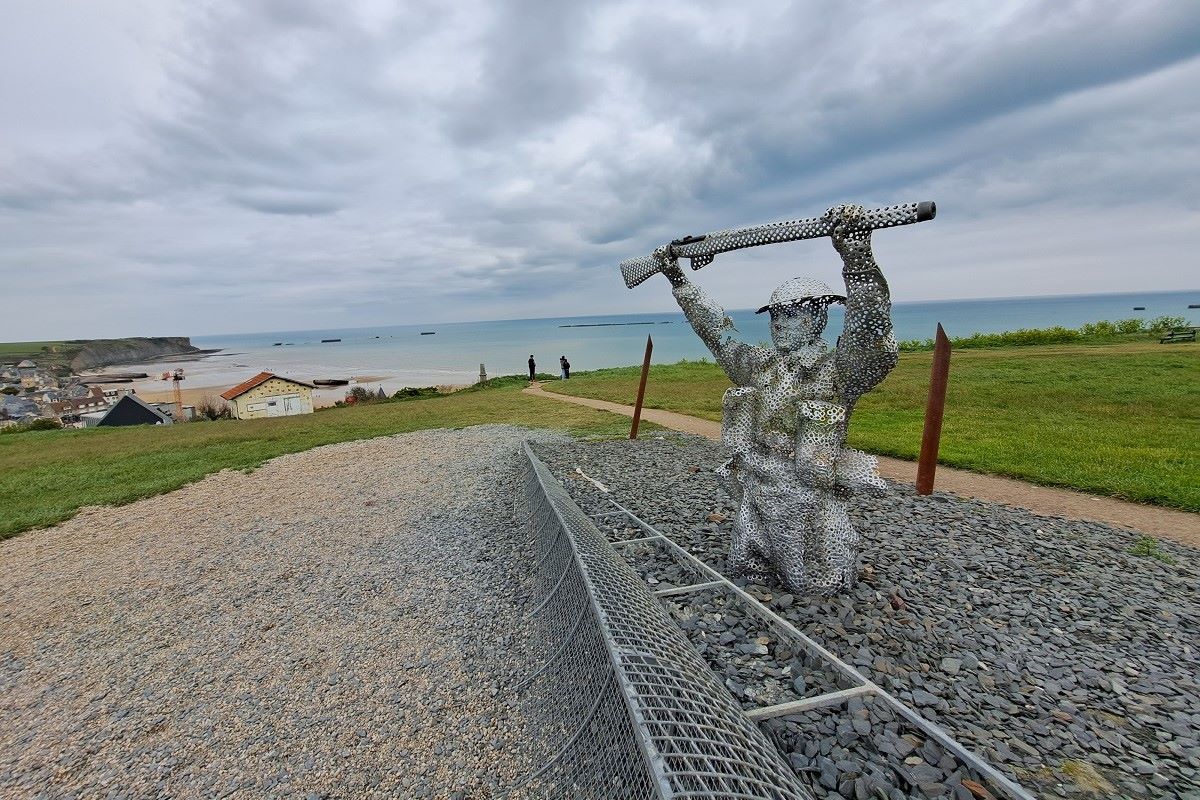
Arromanches and the Mulberry Harbour
We had now reached the outskirts of Arromanches, but to arrive we had to climb the steep ascent to reach the apex of the western cliffs above the town. Having strained leg sinews to reach the top we were rewarded with a magnificent view over the town, the English Channel and the concrete carcasses of the ‘Mulberry Harbour’ that is a permanent reminder of June 1944; it is also the site of ‘Arromanches 360’; a cinematic depiction retracing the 100 days of the raging battle.
Snaking down the cobbled pathway from ‘Arromanches 360’, took us into the centre of the town. Once a sleepy fishing village, the seaside resort was given a new identity the day the British 50th Infantry Division landed on their sandy plains. The town is dominated by the newly refurbished ‘D-Day Museum’, which uses multimedia and interactive displays to explain the logistical brilliance and story of the Mulberry harbour’s conception, building, installation and operation. These artificial Harbours were towed from England and enabled the British army to land reinforcements and stores on a colossal scale.
Bayeux’s medieval masterpiece and onward to Omaha
We departed Arromanches as dramatically as we entered, by taking a narrow footpath that weaves its way up above the Eastern chalk cliffs. The tall grass was growing over the precipice like giant eyelashes, blinking over the dramatic escarpment that looked seaward, as the remnants of the concrete breakwaters disappeared from our view. The Normandy landscape rose gradually from the sea, in softly undulating fields of vibrantly yellow ‘Canola’ plants. With inimitable Gallic charm, the aging farmhouses with overgrown orchards beside grand façades of distant chateaux, were certain to hold their own war time stories, maybe having been used as resting stations or field hospitals for advancing and retreating troops.
The element of surprise, the success of the landings at Arromanches and the rapid in-roads the allies made towards one of France’s great historic treasures, Bayeux, meant it was not devastated in the war. On the approach to the town, the Gothic arms of the historic Cathedral can be seen stretching towards the sky over the quaint Norman town. The true essence of Bayeux came to the fore, with a leisurely stroll through the main high street that retained its ‘Gallo-Roman’ influence. Next to the tourist office in the heart of Bayeux is one of the oldest craft districts in the city. Here the layout of the Aure River banks bear witness to the presence of former tanneries and dye works.
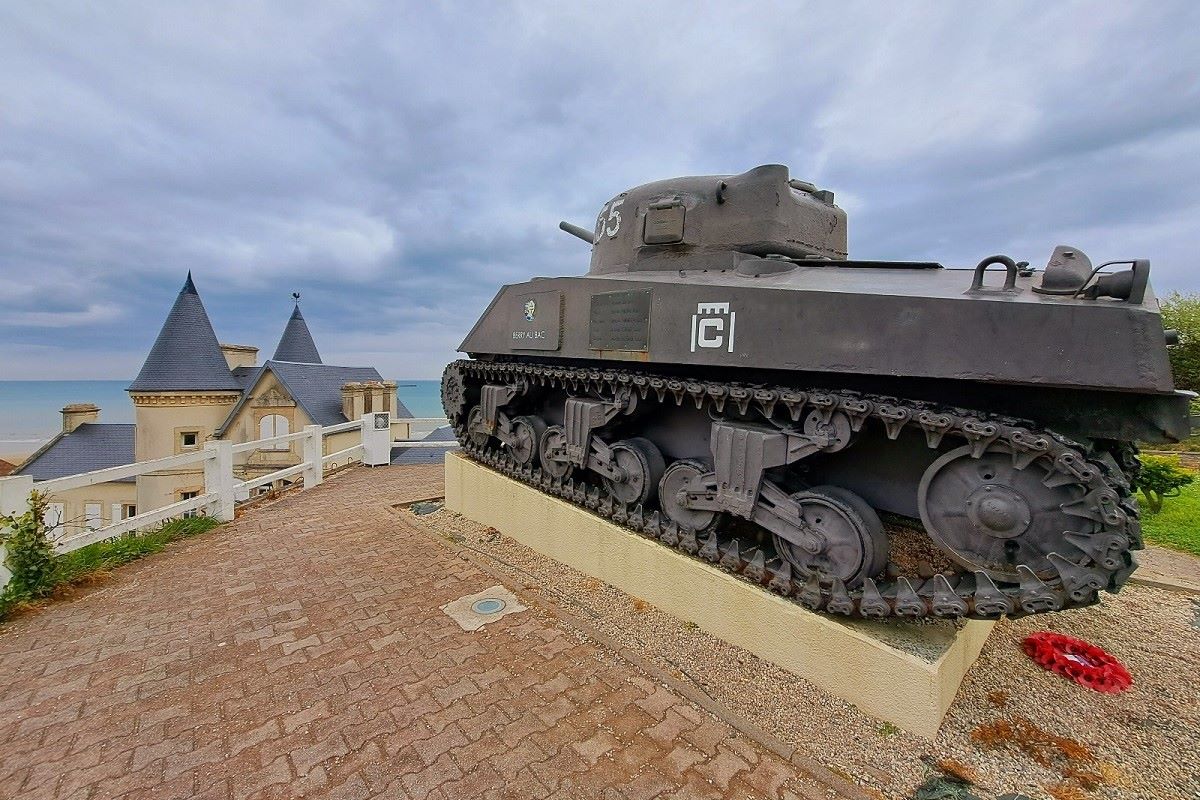
Bayeux is synonymous with the medieval masterpiece, the ‘Bayeux Tapestry’. This embroidery, on course linen, depicts the Conquest of England by the Normans. It provided the inspiration and link for Portsmouth’s ‘Overlord embroidery’ and as we were to find out later, another ‘Occupation’ embroidery found on the Channel Island of Jersey.
Maybe the most poignant part of our hike, was arriving at the Normandy American Cemetery; amongst pine trees, upon manicured lawns, the ‘White Marble Latin Crosses’ spread-out in uniform rows as far as the eye can see, marking 9,386 graves. The cemetery is situated on a bluff high above the coast, with dramatic views along the 10km stretch of Omaha Beach. This was the vantage point from which German troops took advantage of a naturally strong position. With steep bluffs looming over the beach, they could unleash fire and fury upon landing troops, causing over 4,000 casualties, the bloodiest of all the landing zones. As our hike graduated down towards the sandy shoreline, we passed the concrete German resistance nests, before standing on the beach and seeing the perspective from the US 1st and 29th Divisions. Our coastal walk, continued along this magnificently peaceful sandy stretch, with our guide mentioning that some US troops were blown off course and landed further along the beach to less well defended areas, once again the weather playing its part in D-Day.
Jersey
Within the foyer of the historic ‘Pomme d’Or’ Hotel, a grainy sepia photo proudly showcases the moment the Union flag was hoisted from the flagpole upon the hotel’s balcony on 9th May 1945, signifying the Liberation of Jersey. For five long years the Swastika had flown here; the Channel Islanders were the only part of the British Isles to be occupied by the Nazis.
This was a period of extreme hardship and peril for the local population and those brought to Jersey against their will. Of the two Liberation Route Europe (LRE) themed routes in Jersey, one focuses upon the forced workers and slave labourers brought to the Island to construct the many concrete fortifications. The name of the trail is the ‘Forced Workers in Jersey’. Hitler’s obsession with capturing and holding a tiny slice of Britain, meant he diverted a colossal 12 percent of ‘Atlantic Wall’ building supplies for the fortifications, far outweighing their strategic value. Hence, Jersey includes some of the best preserved ‘Atlantic Wall’ defences in Europe, no better exemplified than by one of three main coastal artillery batteries, ‘Lothringen’; situated on the headland at Noirmont, overlooking St. Aubin’s Bay. Entering this multi-level concrete edifice, incorporating periscope and range finder, is to step back to 1944 when it became operational. It’s almost like the German occupiers have just left.
From the entrance of the Pomme d’Or Hotel, one can walk across Liberation Square, passing Philip Jackson’s ‘Monument to Freedom’ sculpture and onward to St Helier Harbour which was the focus of the Liberation of Jersey in May 1945. Various points of interest in this area testify to the heady events of those marvellous days, and these are featured on the LRE themed trail entitled the ‘Liberation of Jersey’. A highlight is the Occupation Tapestry located at the Maritime Museum, which documents the civilian wartime experience over 13 glorious panels.
To revert to the ‘Forced Workers in Jersey’ trail, one can connect some of the Island’s most evocative personal stories and WWII sites, whilst taking in some of the most scenic and dramatic landscapes.
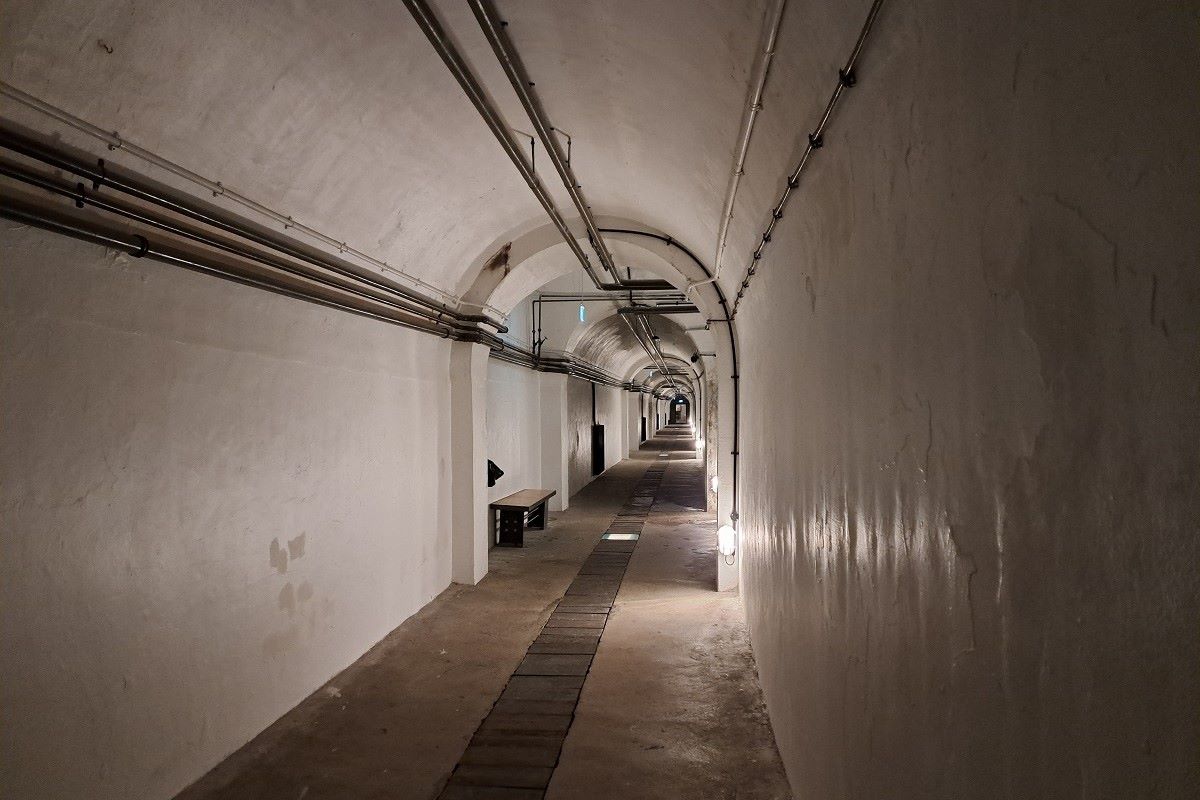
Our tour started at ‘La Hougue Bie’ in the parish of Grouville; a site of immense importance for Jersey, well before the arrival of the German Forces, who made this Island high point the location of a Battalion Command Bunker (Eastern Sector). Here remains a Neolithic passage grave, one of the 10 oldest buildings in the world, with a medieval Christian chapel sitting upon the top of the Neolithic mound. During WWII, the German Forces built an observation tower next to the chapel, whilst the Command Bunker operated their telephonic and radio communications to the Eastern Sector strongpoints and battle HQ. Now the bunker serves as Memorial to the Forced Workers from all over Europe and those that helped them in spite of the inherent dangers. Upon the walls of the dank, grey bunker, is a photograph of Island resident Louisa Gould, who sheltered an escaped Russian slave worker. Her bravery led to her demise at Ravensbrück concentration camp. Louisa’s story has been immortalised in the 2017 film ‘Another Mother’s Son’.
The plight of the forced and slave workers is even more powerfully portrayed within the Jersey War Tunnels. This is the Island’s most famous German structure, comprising of a 1,000m complex of tunnels, dug over 50m underground by hundreds of labourers over a two-year period. This is the most emphatic example of the physical hardships labourers faced, by being forced to create a munitions store and latterly a military hospital to be used in the event of Allied invasion. Now, the Tunnels create the backdrop to the whole story of the Occupation, shining a light on everything from passive resistance, escape, rationing to hardships of daily life and final freedom. Maybe the most poignant part is the dark void of tunnels half complete. Each step we took into the dark abyss, was with the knowledge we could step back into the light; some of the labourers remain entombed in permanent darkness where they were trapped by falling rock.
Maybe more than any other location on Jersey, the iconic La Corbière Lighthouse and St Ouen’s Bay encapsulate the sheer beauty of Jersey’s unique landscape; in the Parish of St. Ouen and across the 4km of spectacular arching golden sand, protected at each end by rocky shoulders, remembrance, nature, history and wellness marry together. Characteristics that are at the heart of the LRE concept. From a promontory, the vast expanse is marked by dog walkers silhouetted like Lowry-stick figures painted into the scenery, as is the 18th century La Rocco Tower, standing sentinel on a rocky tidal shelf half a mile offshore. Today the beach is still protected by German anti-tank wall, with concrete bunkers placed at intervals along its length, their angular forms now softened by grass. At the bay’s northern most point, yet another bunker has become a renowned beachside seafood outlet run by Faulkner Fisheries.
Just around the headland’s south-western corner, La Corbière Lighthouse is overlooked by a [this was a 1960s movement] German World War II observation tower, now functioning as a Jersey Heritage holiday accommodation let. This is one of many ingenious ways, alongside the tide of time and nature, these often ugly fortifications have been enveloped and incorporated into the environment. Jersey is aspiring to become an UNESCO Global Geopark, and such examples of the fusion between the geology and history of the Island will surely set it on its way to become exactly that.
The sacrifice and legacy of the Allied armies was to allow the freedom for our generation to hike, stroll, run and cycle through such an enchanting, democratic and liberated region. Our only job is to step forth and remember them!
Ramy Salameh travelled on behalf of www.liberationroute.com.
Author Bio:
Ramy James Salameh is an award-winning travel journalist and works as an International Reporter for ‘Conference + Meetings World Magazine’. He writes about all aspects of travel in the MICE, business travel, luxury, lifestyle and cultural tourism sectors.
Photographs by Ramy Salameh



Be the first to comment